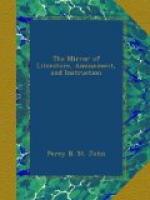231. Scene in Covent Garden Market. One of the best views of the old place, by Hogarth; and one of the last sketches before the recent improvements, will he found in The Mirror, vol. xiii. p. 121. By the way, the pillar and ball, which stood in the centre of the square, and are seen in the present picture, were long in the garden of John Kemble, in Great Russell-street, Bloomshury.
243. Portrait of the late Mr. Holcroft. Dawe. In this early performance of the artist, we in vain seek for the “best looks” of the sitter: such as the painter threw into his portraits of crowned heads.
248. The Happy Marriage. An unfinished picture by Hogarth; yet how beautifully is some of the distant grouping made out;—what life and reality too in the figures, and the whole composition, though seen, as it were, through a mist.
249. Study of a Head from Nature, painted by lamp-light. Harlow. A curious vagary of genius.
258. Daughter of Sir Peter Lely. Lely. We take this to be the oldest picture in the gallery. Lely has been dead upwards of a century and a half.
263. One of Lawrence’s Portraits of himself.
286. Sir John Falstaff at Gad’s Hill. T. Stothard, R.A. The figure has not the fleshy rotundity of the Falstaff of Shakspeare; he is like a half-stuffed actor in the part.
298. Portrait of the late King when Prince of Wales. Lawrence. The features at this period were remarkably handsome; and considering the influence of pre-eminence in birth, the expression is not over-tinged with hauteur. No persons have their portraits so frequently painted as princes; and the artist who has the fortune to paint them at all ages, as Lawrence did, must watch their personal changes with reflective interest, though he may confine them to the tablet of his memory. What an interval between the youthful vigour of the above portrait of the Prince and the artist’s last, fine whole-length of the King, in dignified ease, on the sofa! Alas! lines increase in our faces as they do in the imperfect maps of a newly-discovered country.
313 and 228. Two Landscapes, by Lawrence, reminding us how strongly the artist’s genius was fettered by public taste in Kneller’s profitable glory of painting “the living.”
In the Water-colour Room, are many interesting productions, and some curiosities in their way. We have Paul Sandby and the quaintly precise Capon beside Glover and Landseer—so that the drawings are as motley as the paintings. Here also are Lawrence’s inimitable chalk portraits of his present Majesty and the Duke of Wellington, which show us how much true genius can accomplish in a few lines.




